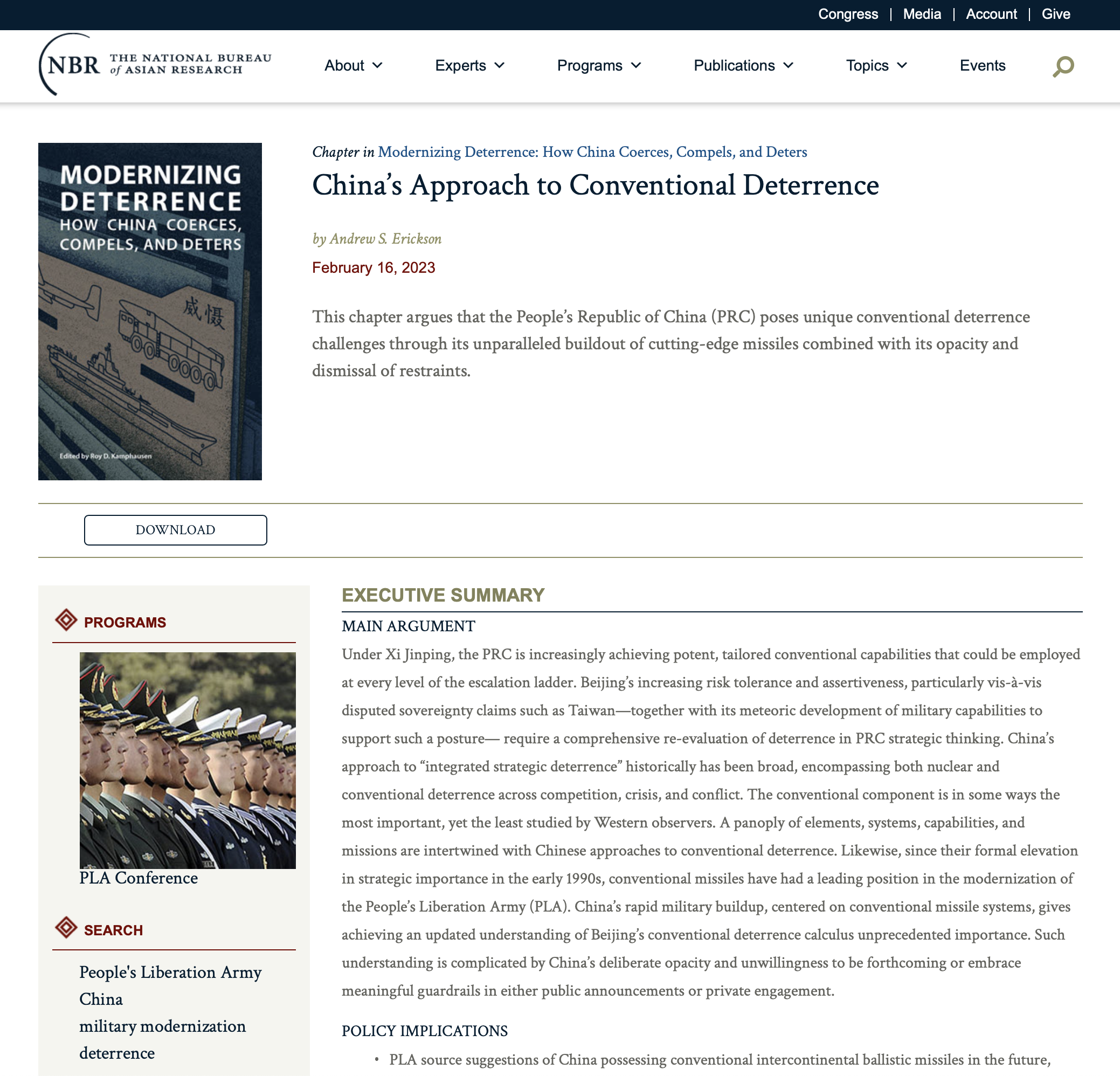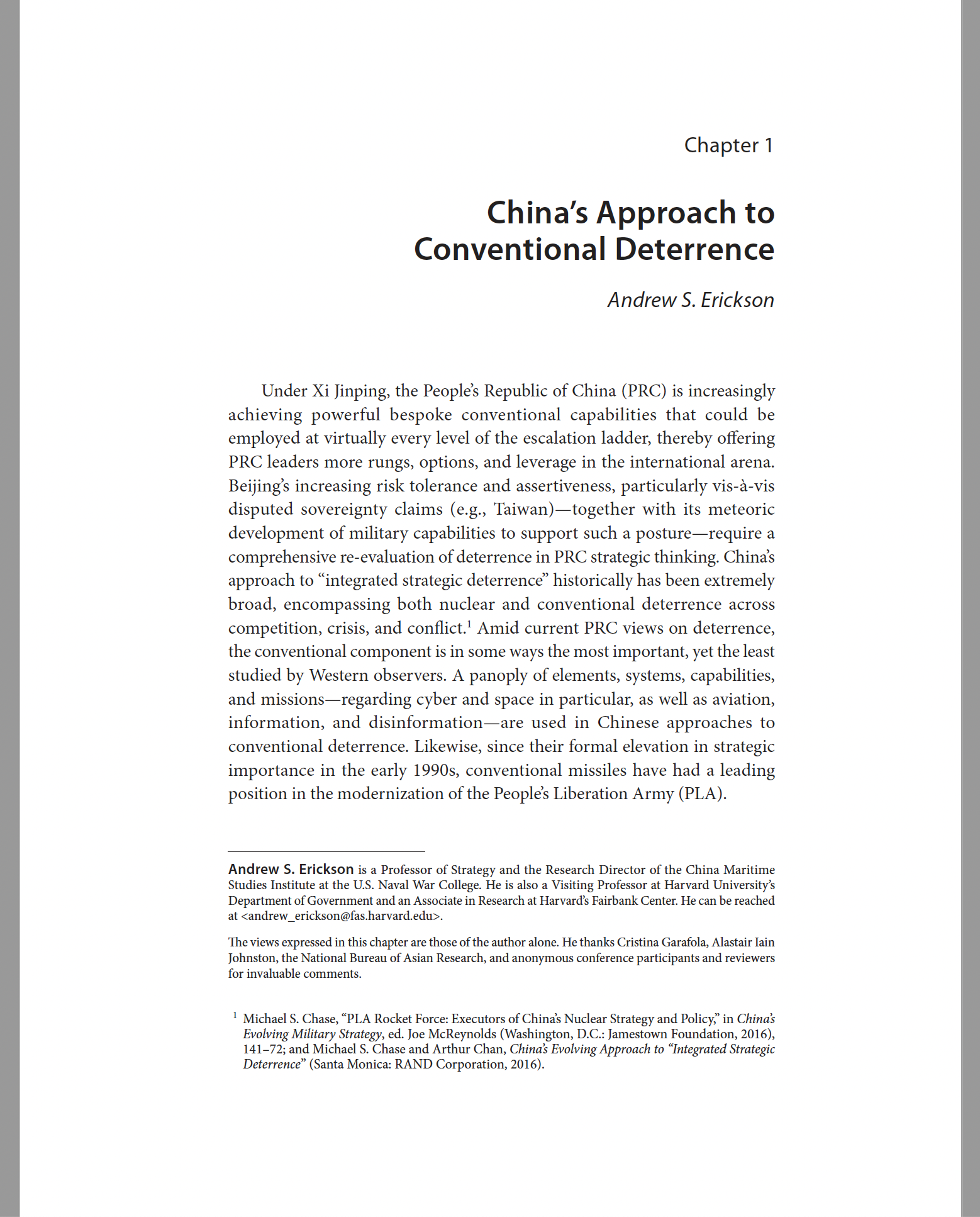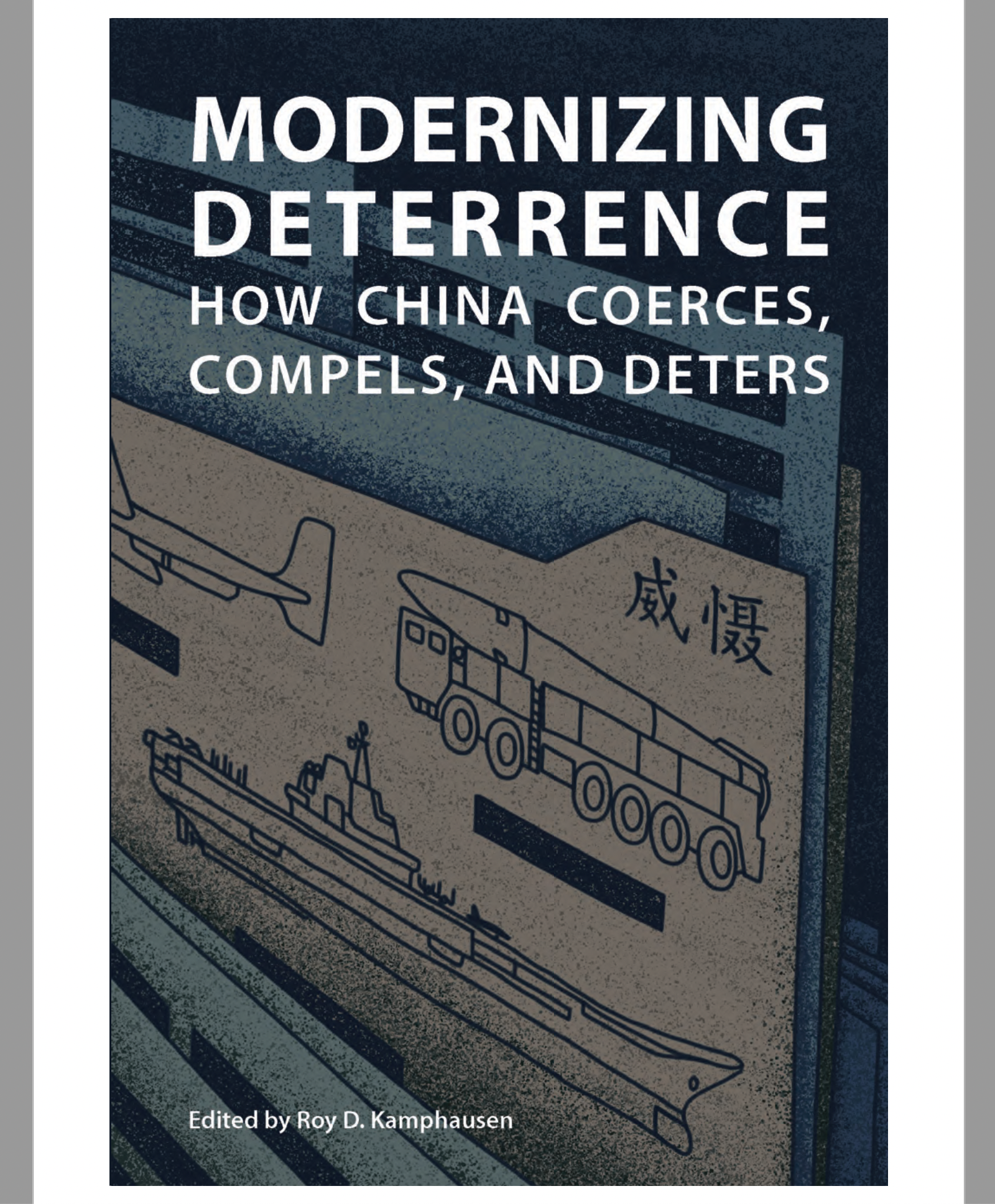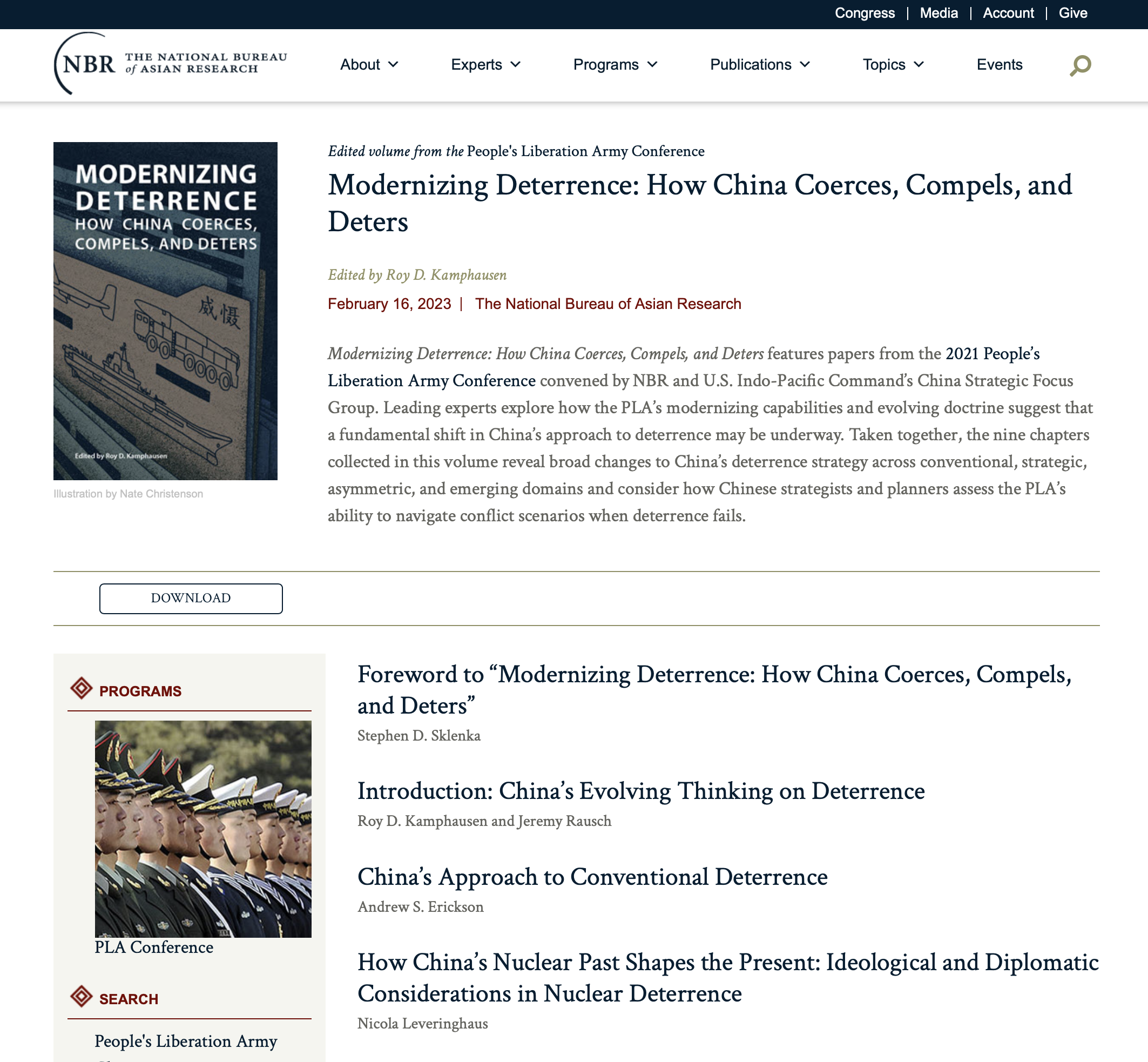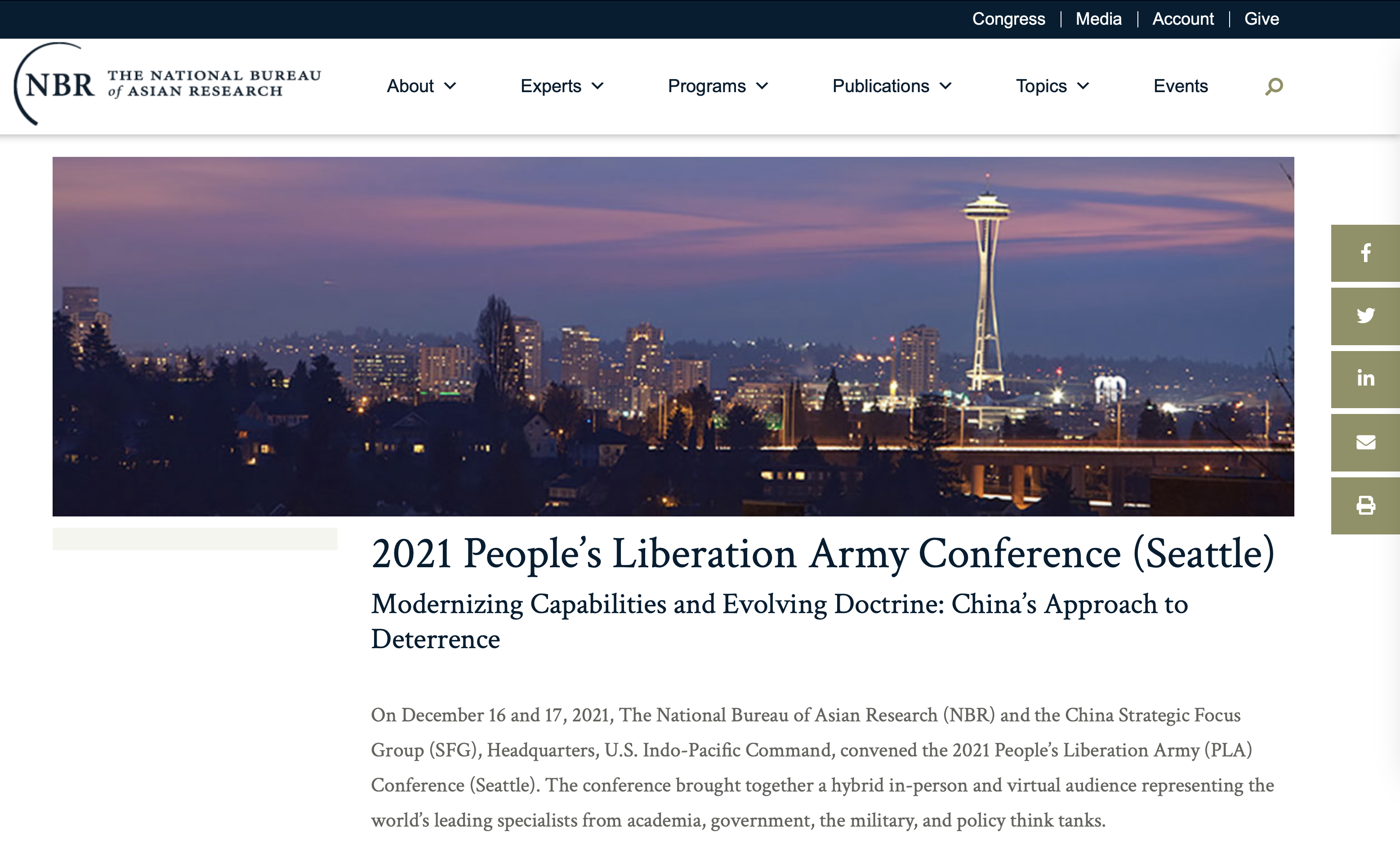China’s Approach to Conventional Deterrence
Andrew S. Erickson, “China’s Approach to Conventional Deterrence,” Chapter 1 in Roy D. Kamphausen, ed., Modernizing Deterrence: How China Coerces, Compels, and Deters (Seattle, WA: National Bureau of Asian Research, 2023), 12–27.
pp. 3–4
Andrew Erickson of the U.S. Naval War College and Nicola Leveringhaus of King’s College London begin the volume with chapters surveying how the PRC has traditionally considered and employed deterrence in the conventional and strategic domains.
In the first chapter, Erickson explores how Beijing poses unique conventional deterrence challenges through its advanced missile systems, opaque decision-making and signaling, and disregard for confidence building. Erickson argues that under Xi Jinping, the PRC is achieving increasingly potent tailored conventional capabilities that could be employed at virtually every rung of the escalation ladder, thereby offering leaders more options and leverage against potential adversaries. While China’s approach to “integrated strategic deterrence” historically has encompassed both nuclear and conventional deterrence, the conventional component is in some ways the more important, if not fully understood by Western observers. China’s rapid pursuit of a range of state-of-the-art systems is making its long-risky calculus concerning conventional deterrence still more destabilizing and dangerous in practice. For instance, Erickson notes that PRC researchers view ballistic missiles outfitted with hypersonic glide vehicles as a transformative technology that China must emphasize in response to similar U.S. (and Russian) developments. In view of Beijing’s increasing risk tolerance and assertiveness, coupled with the rapid development of the PLA’s capabilities to support such a posture, Erickson emphasizes that a comprehensive re-evaluation of PRC strategic thinking regarding conventional deterrence is required.
Chapter 1
China’s Approach to Conventional Deterrence
Andrew S. Erickson
This chapter argues that the People’s Republic of China (PRC) poses unique conventional deterrence challenges through its unparalleled buildout of cutting-edge missiles combined with its opacity and dismissal of restraints.
MAIN ARGUMENT
Under Xi Jinping, the PRC is increasingly achieving potent, tailored conventional capabilities that could be employed at every level of the escalation ladder. Beijing’s increasing risk tolerance and assertiveness, particularly vis-à-vis disputed sovereignty claims such as Taiwan—together with its meteoric development of military capabilities to support such a posture—require a comprehensive re-evaluation of deterrence in PRC strategic thinking. China’s approach to “integrated strategic deterrence” historically has been broad, encompassing both nuclear and conventional deterrence across competition, crisis, and conflict. The conventional component is in some ways the most important, yet the least studied by Western observers. A panoply of elements, systems, capabilities, and missions are intertwined with Chinese approaches to conventional deterrence. Likewise, since their formal elevation in strategic importance in the early 1990s, conventional missiles have had a leading position in the modernization of the People’s Liberation Army (PLA). China’s rapid military buildup, centered on conventional missile systems, gives achieving an updated understanding of Beijing’s conventional deterrence calculus unprecedented importance. Such understanding is complicated by China’s deliberate opacity and unwillingness to be forthcoming or embrace meaningful guardrails in either public announcements or private engagement.
POLICY IMPLICATIONS
- PLA source suggestions of China possessing conventional intercontinental ballistic missiles in the future, including those outfitted with hypersonic glide vehicles, raise the possibility of serious, unintended escalation.
- Long-held overconfidence in “calibrated deterrence”—and the signaling that it implies—is the most dangerous element of Chinese thinking with regard to deterrence and warfighting.
- U.S. decision-makers must unambiguously uphold the credibility of U.S. conventional and nuclear deterrence, including extended deterrence to protect allies from PRC nuclear and conventional threats.
CHAPTER TEXT
Under Xi Jinping, the People’s Republic of China (PRC) is increasingly achieving powerful bespoke conventional capabilities that could be employed at virtually every level of the escalation ladder, thereby offering PRC leaders more rungs, options, and leverage in the international arena. Beijing’s increasing risk tolerance and assertiveness, particularly vis-à-vis disputed sovereignty claims (e.g., Taiwan)—together with its meteoric development of military capabilities to support such a posture—require a comprehensive re-evaluation of deterrence in PRC strategic thinking. China’s approach to “integrated strategic deterrence” historically has been extremely broad, encompassing both nuclear and conventional deterrence across competition, crisis, and conflict.1 Amid current PRC views on deterrence, the conventional component is in some ways the most important, yet the least studied by Western observers. A panoply of elements, systems, capabilities, and missions—regarding cyber and space in particular, as well as aviation, information, and disinformation—are used in Chinese approaches to conventional deterrence. Likewise, since their formal elevation in strategic importance in the early 1990s, conventional missiles have had a leading position in the modernization of the People’s Liberation Army (PLA).
This chapter focuses on the PLA’s conventional missile and strike capabilities—including hypersonic glide vehicles (HGVs) now under development2—and specifically forces and weapons systems within the PLA Rocket Force.3 The elevation of the force to a full service on December 31, 2015, reflects its strategic importance. To elucidate approaches to conventional deterrence in PLA strategy, the chapter assesses PRC views on conventional deterrence definitions, concepts, and doctrine; surveys PLA conventional missile organization and force structure; considers potential scenarios; and offers corresponding conclusions and policy recommendations. The chapter also documents changing doctrinal, organizational, force modernization, training, and other elements of the PLA’s conventional deterrence. … … …
DISCLAIMER & ACKNOWLEDGMENTS
The views expressed in this chapter are those of the author alone. He thanks Cristina Garafola, Alastair Iain Johnston, the National Bureau of Asian Research, and anonymous conference participants and reviewers for invaluable comments.
FOOTNOTES
1 Michael S. Chase, “PLA Rocket Force: Executors of China’s Nuclear Strategy and Policy,” in China’s Evolving Military Strategy, ed. Joe McReynolds (Washington, D.C.: Jamestown Foundation, 2016), 141–72; and Michael S. Chase and Arthur Chan, China’s Evolving Approach to “Integrated Strategic Deterrence” (Santa Monica: RAND Corporation, 2016).
2 All ballistic missiles are hypersonic (faster than Mach 5) at some point in their flight. Germany’s V-2, deployed in September 1944, was hypersonic during its boost phase. Intercontinental ballistic missiles, first deployed by the United States in 1959, are high hypersonic (Mach 25) throughout their entire flight. Subsequent decades have witnessed the emergence of hypersonic missile systems that can maneuver instead of following a fixed parabolic trajectory, including anti-ship ballistic missiles (ASBMs), HGVs, and air-breathing supersonic combustion ramjets (scramjets). The United States investigated maneuvering re-entry vehicles in the late 1970s, and the Soviet Union investigated HGVs in the mid-1980s; both failed. In 1981 the United States fielded the Pershing II medium-range ballistic missile (MRBM), whose terminal braking maneuver has been widely attributed to China’s DF-21D and DF-26B ASBMs. In April 2010 the United States successfully tested the first HGV, the Falcon HTV-2. The restarted Russian HGV research and development effort (Project 4202, which would become the Avangard) appears to have taken a little longer. What is “new” is the recent fielding of mature, hypersonic missiles with maneuvering payloads by U.S. adversaries. Russia has developed the Avangard HGV and has fielded, or will soon field, the scramjet-powered 3M22 Zircon hypersonic cruise missile. China has fielded the aforementioned DF-21D and DF-26B ASBMs, as well as the DF-17 (likely with the DF-ZF HGV). All of these systems use speed and maneuverability to greatly complicate the defender’s problem. Maneuvering potentially enables approaching from unexpected angles to strike a moving target on land or sea. Nonparabolic trajectory allows approaching at lower altitude. Trade-offs include slowing significantly (typically below Mach 10) to mitigate the ionized plasma field that inhibits active radar sensors typically employed to seek targets.
3 While the PLA Rocket Force remains the mainstay for conventional deterrence missions regarding long-range strikes, there are increasingly roles and missions to which the PLA Air Force, Navy, and even Ground Force contribute. The PLA Air Force has fielded roughly 100 modernized H-6 bombers in recent years, many of which are capable of carrying six CJ-20 land attack cruise missiles (LACMs) and can reach Guam. Additionally, the H-6N bomber is fielding a nuclear-capable air-launched ballistic missile (ALBM), the CH-AS-X-13, and China is also working on the H-20 low-observable strategic bomber with assessed nuclear and conventional roles. PLA Navy surface vessels are fielding anti-ship cruise missiles (ASCMs) ranging from 250 kilometers to over 500 kilometers. Larger combatants will obtain ASBMs, and some ships will get LACMs, too. PLA Navy submarines may field long-range LACMs as well. PLA Navy Aviation has a relatively long-range ASCM role with the supersonic YJ-12 (up to around 250 kilometers). Even in the PLA Ground Force, long-range artillery ranges several hundred kilometers.
… … …
INFORMATION ON EDITED VOLUME
Modernizing Deterrence: How China Coerces, Compels, and Deters features papers from the 2021 People’s Liberation Army Conference convened by NBR and U.S. Indo-Pacific Command’s China Strategic Focus Group. Leading experts explore how the PLA’s modernizing capabilities and evolving doctrine suggest that a fundamental shift in China’s approach to deterrence may be underway. Taken together, the nine chapters collected in this volume reveal broad changes to China’s deterrence strategy across conventional, strategic, asymmetric, and emerging domains and consider how Chinese strategists and planners assess the PLA’s ability to navigate conflict scenarios when deterrence fails.

